How will my nests connect with the theme of RASA (NGO art project where I work as a volunteer/facilitator) called Breath, Breathe and Winged Things during the Solo Studios exhibition planned for August 2024?
The RASA exhibition will be curated by RASA founder and art curator Gerd Dierckx and Quientin du Plooy. This yearly exhibition takes place in our village and is owned and managed by a collective called Solo Studios 2024 (www.solostudios.co.za). Local artists open their studios during the event, local galleries participate, life performances are organized, and even long-table gourmet events are hosted. It seems around 33 artists will partake.
I want to use the blog as a ‘thinking tool’ and will add more thoughts over the following weeks starting on 10/06/2024. I feel comfortable using this blog to breathe and connect with others around the chosen theme. I will share my thoughts with the curators, my tutor, facilitators and other participating artists.
Contextualising my thoughts
When I contemplate my work around nests, I reflect on the deep story behind their creation. The concept of care permeates my work, representing nurturing, protection, concern, and loss. Inspired by a video conversation between Joan Tronto and Todd May on the Philosophy of Care, I considered how, in making nests, I might receive care rather than just giving it—could the nest itself be the carer? This prompted me to think of an installation in a public space and a considerable wire nest, which is currently a work in progress to present as part of the RASA collective exhibition during Solo Studios, 2024.
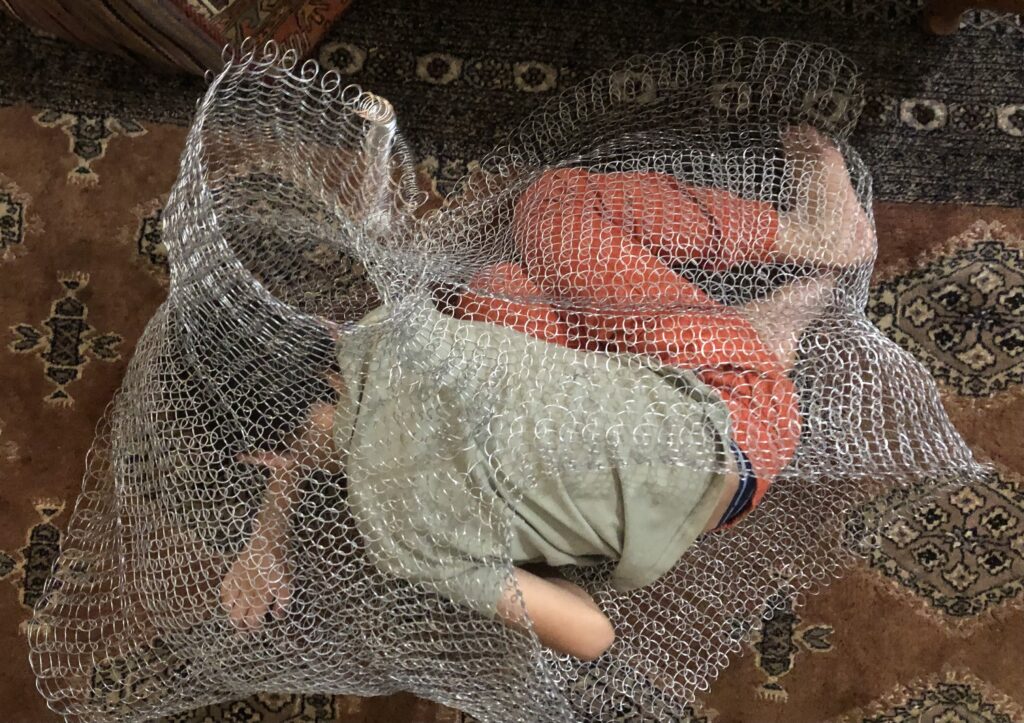
Researching Ruth Asawa’s wire sculptures emphasized transparency and other vital material properties and gave me a deeper understanding of her work. Her sculptures are physical objects and dynamic entities that engage with light, space, and the viewer’s perception. This wire transparency transforms these works into living, breathing pieces that change with their environment, embodying a delicate balance between strength and fragility, presence and absence. I feel my exploration of the material properties of wire can enhance viewers’ appreciation of the intricate beauty and conceptual ideas around breath and breathing. Nests symbolize more than just physical structures; they represent spaces for breathing, just being, connecting with nature and self and the care that sustains us all. Through my nest installations, I aim to create an embrace for viewers, reminding them of nature’s endless wonders and the universal need for care and connection.
Nests carry profound meaning and evoke strong feelings for me. The meditative process of making reminds me of the essential act of breathing, mirroring the rhythm of breathing. The act of making is mostly mindful and rhythmic. By inviting the viewer to partake in the making, I am creating a space for breathing: a repetitive and contemplative space.
By infusing my work with personal narratives and philosophical insights, I invite viewers to embark on a journey of introspection and empathy. I am open to sharing that the loss of my youngest son shapes my personal story. His death by suicide has left an indelible mark on my life. My work reflects the emotional landscape of dealing with this loss, contemplating the moment when a child leaves home (nest) and the parent’s poignant struggle of letting go and the now emptiness of his death. Creating nests becomes a way to process and express this experience’s complex emotions. Each nest embodies the care, nurturing, and protection that defines parenthood, as well as the profound sense of loss and letting go, and the almost overwhelming sense of impermanence of life that comes with the death of a child. Through my art, I explore my dual roles of caregiver and care receiver, finding solace in the meditative act of making. The nests represent a space for new beginnings and a sanctuary for grief, offering a place to breathe and reflect.
By sharing my story and inviting others to connect with these themes, I hope to create a space where viewers can find their paths to understanding and healing, recognizing the universal need for care and connection amidst the fragility of life.
(Question to myself: do I want my viewers to engage on such a resounding/emphatic level? I share deep and personal feelings in this writing, which requires sensitivity and clarity. I find the materials are taking me to places where I consider the ‘stuff’ that my world is made of and hopefully learning to see afresh)
I also think one could highlight nests’ dual nature as anchors and launchpads. They are places of safety and origin yet also starting points for flight and exploration. This can be reflected in the presentation of the nest work by juxtaposing grounded nest structures with elements that suggest upward movement or flight. The nests could also appear to be transforming or breaking apart as if they were about to take flight. This can symbolize the moment of transition from being earthbound to soaring.
Another idea that I considered is to think of the nest as a ‘dreamscape installation’ that brings childhood dreams of flight to life. Suspend nests from the ceiling, create a pathway that simulates flying, and use light and sound to evoke a dreamlike state. One can work with lightweight materials and gentle movement to create an airy, floating feeling. Incorporate interactive elements that allow viewers to engage with the nests and experience the fantasy of flight firsthand.
I consider a sculptural piece where the large-scale nest transitions from a grounded nest structure at the base to an expansive, wing-like form at the top, symbolizing the journey from earth to sky. To execute I can use wire to create a solid nest base, gradually integrating lighter materials and more open, airy structures as the sculpture rises. Add elements that evoke movement and flight, such as flowing fabric or kinetic parts.
The curator, Gerd (RASA) feels we should be inspired by the work of Laure Prouvost. Below is some research ( I followed this up with a separate blogpost on my research into her work)
Prouvost is a French artist living and working in Brussels, Belgium. She won the 2013 Turner Prize. In 2019, she represented France at the Venice Biennale with the multi-media installation Deep See Blue Surrounding You. Her work is very much about exploring the boundary between fiction and reality. It’s fair to say that her work should never be taken literally; it is a playful provocation, and she combines the real with the imaginary. She will incorporate video installations, sculpture, and mixed media into these works. Prouvost’s work addresses miscommunication and ideas becoming lost in translation. Playing with language as a tool for the imagination, Prouvost is interested in confounding linear narratives and expected associations among words, images and meaning. She combines existing and imagined personal memories with artistic and literary references to create complex film installations that muddy the distinction between fiction and reality. She sees herself as a translator – creating a moment, an emotion or as sensation, with her works – the viewers can become it physically as the work is so immersive. idea to experience her work physically is very strong.
My main thing I learn from her process is that she responds to places, spaces and situations. Her installations are multi sensory experiences.

The process of making is important
By making wire objects with my hands, I engage in thinking that integrates mind, body, and material. This embodied cognition allows for an intuitive, responsive, and mindful creative process. The physical experience of nest-making requires precise hand-and-finger coordination and repetitive actions, which I find both satisfying and contemplative. This interaction with the material is a dialogue between the maker and the medium. As I shape the wire, it shapes my thoughts and ideas, leading to an evolving creative process informed by the material’s characteristics.
Final suggestion is that I make an armature. I will not display my nest at this collaborative exhibition.
Visitor Participation during the exhibition
There will be a separate piece for interaction where work will hang from the armature and viewers be invited to make flying objects to add to the work. There will be tables, (with some instructions) where facilitators will guide/invite viewer to use different materials to participate in making. A winged form was decided on, and I decided to make a small prototype to explore ideas with the creators and facilitators. This armature will be at least 7 m long and 1.5m on its widest part and be made of galvanised wire at least 4mm wide. I will be suspended from the ceiling and give structure and support to mobiles hanging from it. The first three images is of a wing. I added spirals and Calder-type mobiles to the ‘mock-up’ (images below) The idea is to hang more of these in preparation for the objects to be made. We will use light from the ceiling to make use of shadows and movement (breeze)

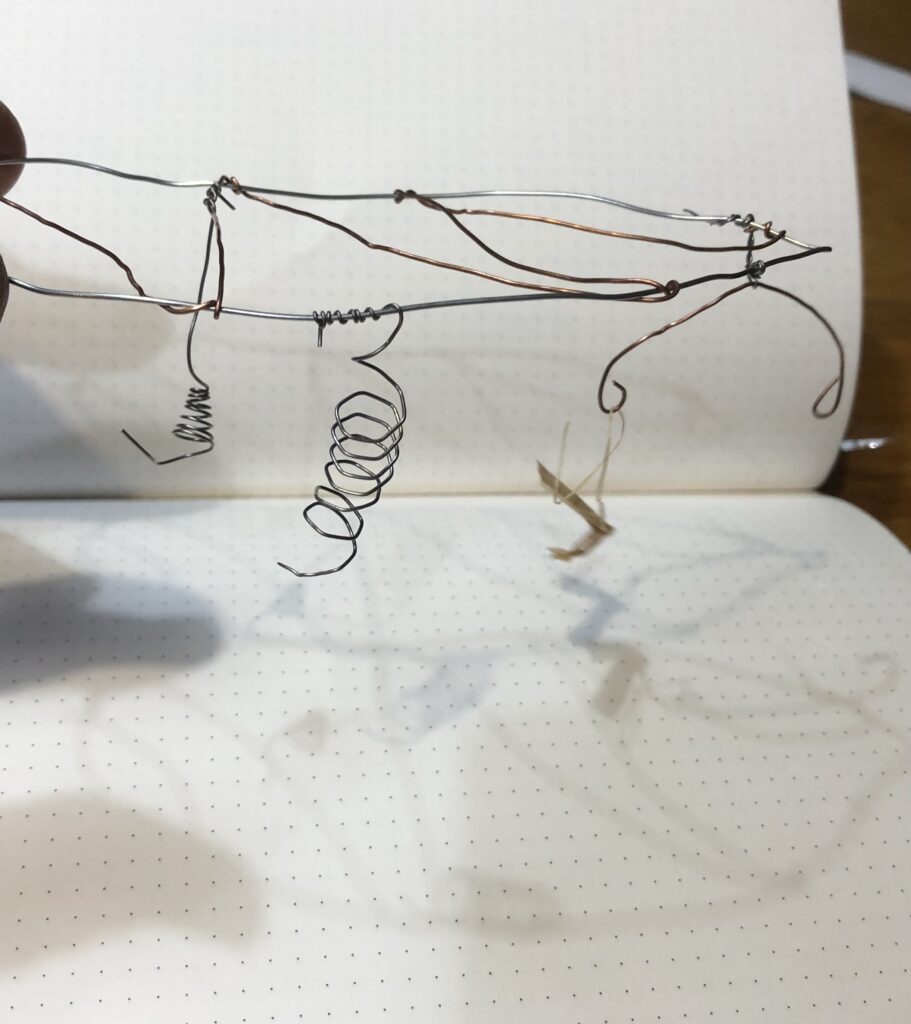

More objects will be made during the last few weeks of July in the Kunsklas, and we will also invite visitors to work during the exhibition. A list of materials was created and shared with the community to ask to bring along and/or drop at specific points in the village. There will also be a box with philosophical questions about art and creativity to share with visitors and interact around these questions.
Below is another option to consider, this is after the work of Barbara Hepworth, Winged Figure, 1962. The scale of her work is impressive and here I have the opportunity to make the work at least 7m long. I love the abstraction in the work made in Aluminium Sheetmetal. It gives me the opportunity to explore how light can flow through a wing-like object as it hangs suspended from the ceiling. I will allow for more ‘holes’/light in the work. I need to consider weight and the size. I can use it as a separate work in my body of work, or combine it with other work.

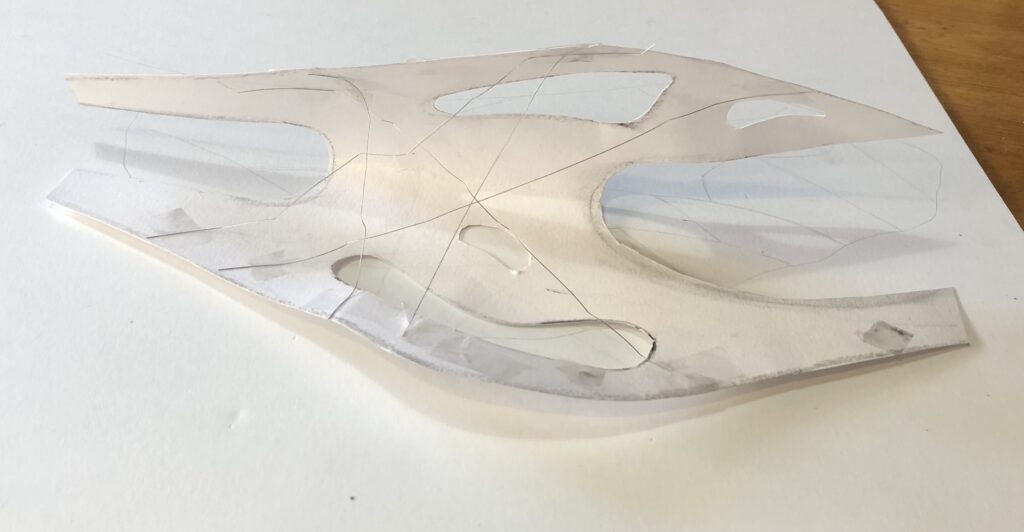
Hepworth was a great admirer of the socialist ethos of the John Lewis business, where her sculpture would be installed in their flagship shop on Oxford Street, London. This shop was collectively owned by its workers, and she was attracted by the prominence of the site. The design was praised for embodying ‘the idea of resurgence or aspiration.”
PLANNING FOR RASA EXHIB meeting with group, Mon 24/06/2024
WORKSHOP during the exhibition:
- Project with MA student during the workshops: Consider the weekly art classes and join the class. Way to test the process out – mobile made to develop.
- My chat with Sharon (facilitator at Rasa)to plan the rest of the sessions for SoloStudio participation.
- Notes on Mobile: Gerd—the mobile how-to assemble—ask people in the community (Quenten) to contribute materials, make a list. We need a glue gun and extension cord—ask to deliver at Andries and in Riebeek West—bring and invite to come and join, see, and make with it.
- Focus on the Laura Provouste exhib – how she uses light materials. The question is about balance; the lighter, the better, not heavy, is about airiness and breathing. The idea of walking through – like a maze – walking through it. The way we hang – consider the facilitator’s help – do not want a wonky making. The structure we will use – l
- List of materials, such as a Steel ruler, chifonny paper from Adrienne, wine corks,
- Design in shape of wing, the armature is to be considered (end June)
- Meeting at space on 3/07/2024 – decide on size of armature and will use wire for wing
The artists:
Walker – prints of her photographs of dragonflies on tissue paper
Amy Rush – 3 works one hangs
Emma – large piece – Breeze bush pulled out by the roots – drawings
Videos – Adrienne – cushion – show it on screen – dark corner/black box/black curtains see the projection – get aware of the work
Sonia Rademeyer – video only stills available. Ask for a snippet of the video
Who will visit and partake?
For grown ups as well – co -created exhibition
VISI, House and Leisure, – press release to use
Nest with wire
As this nest is taking on form I considered how working with my hands becomes part of a space where feeling and thinking meet – I want to create a large work, have to find the form with my hand making and must admit that I cannot always control the form of the work as it is growing in size. Is the unpredictable part a learning with the material? Can I say it has to do with interconnectedness – to become part of something, something which is more than just me making something? I find that I more and more look at sculptural installations.
Considering nest making and using paper – I like the idea of creating form, but also to consider how easy it can unravel or collapse into a formlessness. I came upon the work of a Japanese American artist,Kiyomi Iwata. She works with an unusual silk thread called kibiso. A silk worm usually spins about 3,000 meters of thread during its lifetime. It is the first ten meters or so that are called kibiso. Because the thread is rough and stiff and therefore unsuitable for weaving fine silk cloth, it is usually discarded. With this new material in hand, Iwata changed her approach to making her art. Instead of looking for material to realize a preconceived idea as she had in the past, she now began to investigate ways to use material. The unusual nature of kibiso thread led her to an exploration of line instead of volume. Using dyed and stiffened kibiso, Iwata began making simple container-like forms of very loosely woven thread. The effect, as in Kibiso One (2009), resembles a container form outlined in swirling thread that seems to be unraveling before the viewer’s eyes. Even more dynamic is Entanglement (2011), another work made of kibiso thread, but this time with pieces of rice paper wrapped around it and embellished with splotches of dark paint. More mound-like than container, Entanglement, as the name suggests, also seems a bundle of swirling energy, of something on the cusp of either coming into being or collapsing into formlessness.
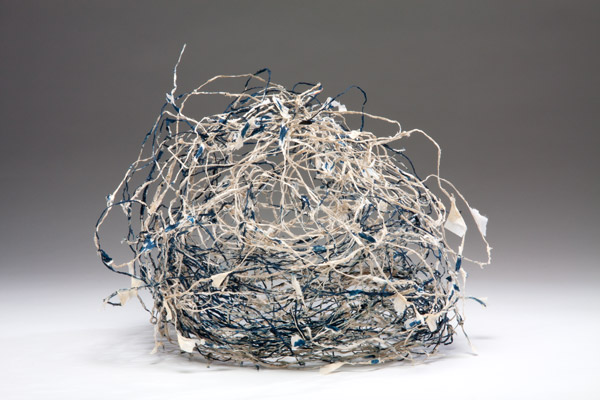
Birds, particularly sociable weaver birds, inspire me. Their collective nest-building reflects communal living and shared care. Observing them has taught me about the strength and beauty of working together to create nurturing spaces. I have watched birds over many years to learn about different birds. By working with the sociable weaver birds’ nest I came closer to observing collective ways they live. The exciting thing about their making is that they do not weave their nests like other ‘weaver birds’ but stack and layer with found materials.
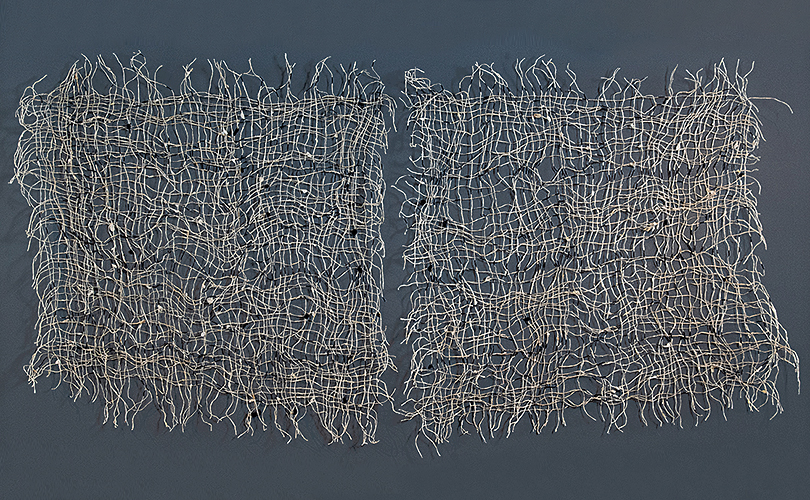
I am knitting with a silver thread – her work inspired me to consider using my loosely knitted from to create nestlike forms. I could use a conitous ‘string’ of stitches cast on as my material to ‘weave’ with or into the wire forms I have created. I like the knitting process – the outcomes reminds me of fragments are are quite freeform. I wonder how they will ‘look’ inside a frame?
As Joan Tronto eloquently states:
“Care is a species of activity that includes everything we do to maintain, contain and repair our ‘world’ so that we can live in it as well as possible. That world includes our bodies, ourselves, and our environment, all of which we seek to interweave in a complex, life-sustaining web.”
I have read about birds in mythology.
Everyone likes birds. What wild creature is more accessible to our eyes and ears, as close to us and everyone in the world, as universal as a bird?” Sir David Attenborough
A friend shared an art project, which will happen in June:
“For its second participation of the Civilisations art fair, Duende Art Projects has selected a group of 23 antique African artworks depicting or featuring birds. As “A Flock of Birds” explores avian inspiration across the African continent, we present sculptures from the Ivory Coast, Guinea, Nigeria, Ghana, the Republic of Benin, and Burkina Faso. Given their natural faculty of flight, all over Africa birds were associated with transcendence and other supernatural abilities. Already in Greek mythology, birds were considered to be messengers of the gods, having the ability to communicate between the mortal and divine realm, just as the bird is a common symbol of communication and wisdom in many West African societies. Avian sculptures could represent deities, commemorate events, elicit moral lessons, evoke sayings, or recall certain bird’s characteristics. Close observation of the animals’ peculiar behaviours made them inexhaustible sources of inspiration, while talented artists with great craftsmanship created wonderful works of art for us to enjoy.“
(Personal notes after sharing this writing to consider. Should I name my loss – I am mostly weaving around it in the ubove text. Importance of naming it to be considered. Name the core, why is the care there? S talks around her work being intuitive – in the moment: the lived experience of caring and how it flows out. Ideas around materiality – very focussed.)
Thinking about my continuous search and exploration – is it just a space where I am now? I wonder about thinking and unknowing. I contemplate Jane Bennett when she states (2010) that “..if we think we already know what is out there, we will almost surely miss much of it.” I like this gap between knowledge and unknowing (Jane Bennett, Vibrant Matter: A Political Ecology of Thing, (Durham and London: Duke University Press, 2010), p. 15.)
Thinking about breath
I read that in the Dogon language, the word for woven cloth also means ‘the spoken word’. The root term for weaving and speaking is the same.
I became interested in whether and how art can explore and express the multifaceted dimensions of breath, catalyzing ideas of connection, reflection, and transformation. Through various artistic mediums and approaches, artists can evoke breath’s rhythmic, sensory, and symbolic qualities, inviting viewers to engage with their work on both an intellectual and embodied level.
Exploring breath in art can illuminate respiration’s physiological and experiential aspects and delve into deeper philosophical, emotional, and interpersonal themes. Whether through performance, installation, sculpture, painting, or multimedia experimentation, art offers a space for contemplation and dialogue around the profound significance of breath in shaping our lived experiences and relationships with ourselves, others, and the world around us. One can consider what happens when you stop breathing….. breath is life! I also contemplate the other truth: we breathe in oxygen and exhale carbon. It is not just our physical nature that makes us ‘greenhouse gas emitting species’, but also how we produce by burning fossil fuels.
Breath and life: The drawing below was made after a new friend whom I was only getting to know, died very suddenly and tragically. She was on life support for a few days, but never regained consciousness.
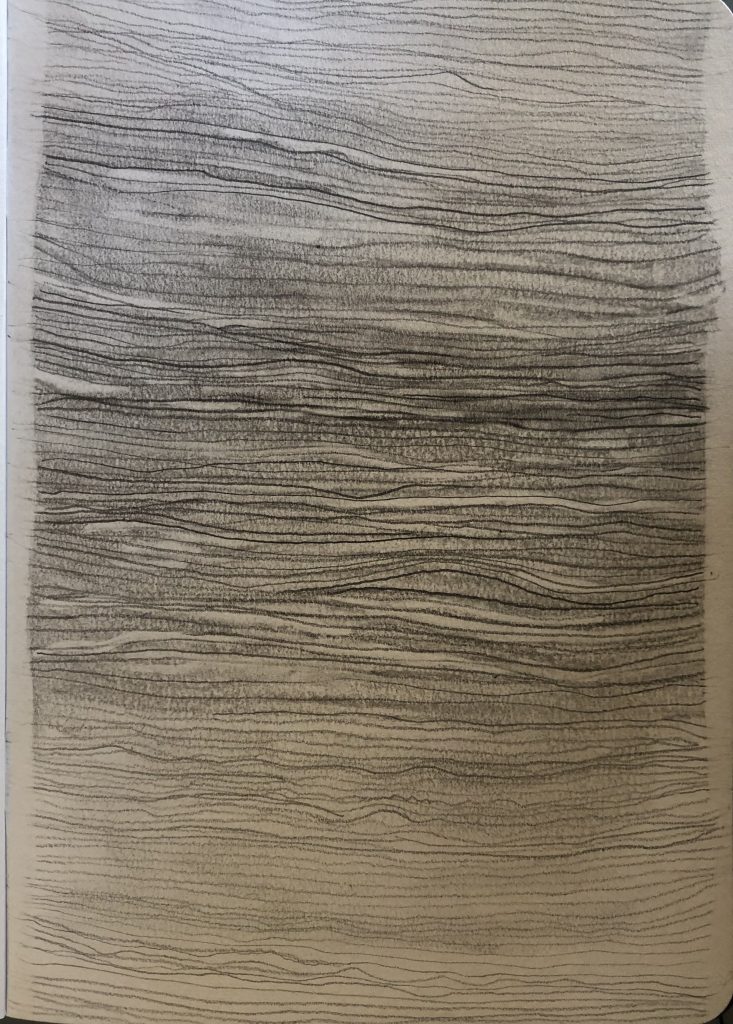
With this drawing, I contemplated the idea of temporality and mortality. These huge sociable weaver nests can last for up to 100 years and host many families who need to maintain them. I would like to consider temporality and mortality through these nests—can the wire(steel) nest carry this meaning, ideas around birth, growth, and death? In our world, we see more ‘temporary’ homes than solidly constructed homes which belong to generations – can my steel structure refer to this temporality due to displacement, poverty, and social insecurity, but also just the beauty in things ‘impermanent’? The nest is ‘open’ there are no secrets, we can ‘gaze into’ a space which is supposed to be where we feel nurtured and safe – what can we contemplate around this?
I recently read about a work by a local artist,Rina Stutzer, Recognising the Sojourner. This work is an abstracted corvid motif constructed out of temporary housing materials such as tenting fabric, steel, cord & pegs, which stems from an encounter with a dead crow during an artist residency 2013. The article explained that a sense of solemnity attends this work, which addresses all frailty; while not loosing the poignancy of a significant encounter with a complete ‘Other’ – a haunting memorial that will be folded away. I hope to find images of this work. (10/06/2024 – https://www.academia.edu/7729827/The_birds_and_the_dogs_and_the_wild_ones_NIROX_Foundation_Winter_Sculpture_Fair_2014_?email_work_card=view-paper )
Through encounters with breath-inspired artworks, viewers can be invited to pause, reflect, and connect with their breath and the breath of others, fostering a sense of empathy, presence, and interconnectedness. In this way, art becomes a powerful tool for exploring the fundamental aspects of human existence and the transformative potential of mindful awareness and creative expression. One can draw/paint the Japanese Enzo circles.

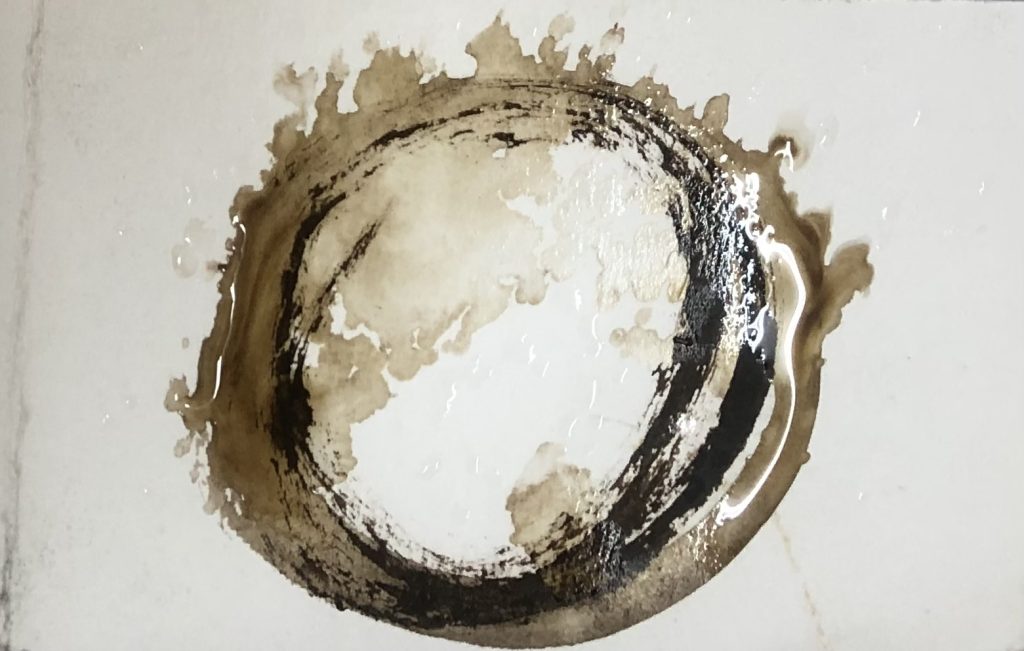
I could consider an interactive installation that invites viewers to engage with breath in tangible ways. For example, use sensors that respond to participants’ breath, triggering changes in light, sound, or movement. This interactive feedback loop encourages viewers to become more aware of their own breath and its effects on their environment.
I came upon the work of Jane Balsgaard (from Denmark), who uses wood and paper to create objects that reference boats, sails, and wings. She sometimes incorporates artefacts into her works to reference the old and the organic.
Balsgaard spent time in Japan in 1993 and 1998, preparing for exhibits there. Works of paper and twigs were the result. In her work, white paper often contrasts the dark color of the willow twigs. “Another element in her works that has connection to Japan,” writes Mirjam Golfer-Jørgensen, “is the skeleton, that partly frames the paper, partly combines with the hollows in the construction, and gives another character to the paper that with a lightness that creates a contrast towards to the hollows.” (Influences from Japan in Danish Art and Design 1870 – 2010, Mirjam Golfer-Jørgensen, Danish Architectural Press, 2013.)
I recently came upon the work of Laura Ellen Bacon, who works mostly with willow. Her first exhibition is currently (13- 31 May 2024) in Londons Hignall Gallery, and the following description of her work is inspiring: “In this first solo exhibition of Bacon’s work in London, the tactile works have weight, presence and a strange quality as if they have always existed. Using a language of form that feels familiar to the natural world. The exhibition is transporting in its human scale and a sensory delight in this historic interior setting. Upon entering the space, you first become aware of the fragrance of the willow and thatch. We are reminded that nature can still surprise us.” (https://hignellgallery.com/exhibitions/43-laura-ellen-bacon-burrow-marquis-house-68-jermyn-st-st.-jamess-london/overview/)
Podcast (Acca) around the work Deep See Blue Surrounding You. The subject became the invitation – her own identity as she had not lived in France for a long time – to not belong, imagine a world without frontiers. A sense of freedom came through her work – or to ‘trespass’. Is it the adrenaline? Creating is trespassing to arrive somewhere else – push elements/language/cut/reassemble it. It is not always the front door; you could use the back door. Her work is complete with intuition – feeling the moment, using pre-written text. How to articulate what you want to do? Collage – provoking each other?
We Will Be Birds Who Belong To No Nations, 2019, oil on paper
Presented in the Palais Royal – Musée du Louvre metro station and in front of the France Pavilion at the Dubai World Expo.
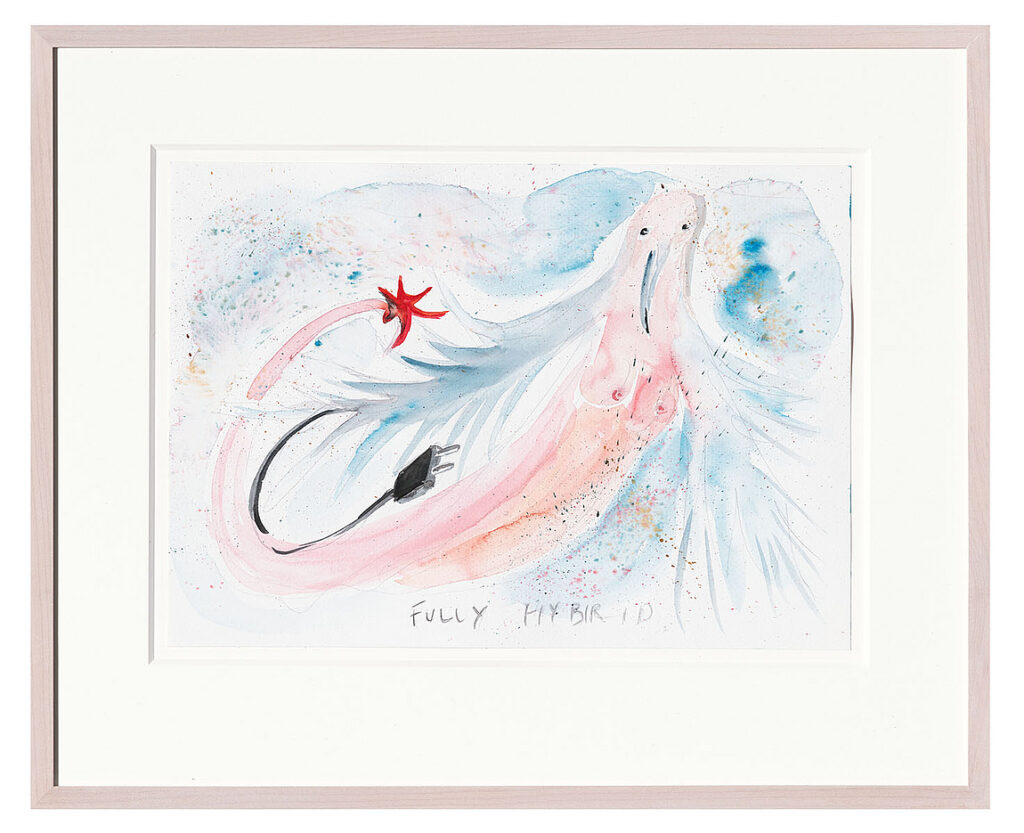
11 June 2024 : Rewriting my thoughts for SOLO STUDIOS 2024
In my nest-making as art, I infuse each creation with personal narratives and philosophical insights, inviting viewers to embark on a journey of introspection and empathy. Through this process, I aim to foster a deeper appreciation for life’s intricacies and the bonds that unite us.
The materials I use in creating nests take me to places where I reconsider the ‘stuff’ that my own world is made of, allowing me to see afresh. Nests symbolize home, care, and resilience for me. They represent the transient nature of life, the strength found in community, and the cycles of growth and renewal.
Creating nests is a meditative process that mirrors the rhythm of breathing, providing a space for reflection and mindfulness. Each nest embodies themes of care, protection, and the delicate balance of letting go and holding on.
By sharing these nests, I invite viewers to connect with the universal themes of home, community, and the enduring human spirit. Whether contemplating the resilience of nature or the intricate web of relationships that shape our lives, I hope my work inspires a deeper understanding and appreciation of the world around us.
PLANNING FOR RASA EXHIB meeting with group, Mon 24?06/2024
Project with Helaina during the workshops: Consider the weekly art classes and join the class. Way to test the process out – mobile made to develop. My chat with Sharon to plan rest of sessions for SoloStudio participation. Notes on Mobile: Gerd – the mobile how to assemble – ask people in the community (Quenten) to contribute materials, make list. Need to have a glue gun: extension cord – ask to deliver at Andries and in Riebeek West – bring and invite to come an join, see and make with.
Focus on the Laura Provouste exhib – how she uses light materials. The question is about balance; the lighter, the better, not heavy, is about airiness and breathing. The idea of walking through – like a maze – walking through it. The way we hang – consider the facilitator’s help – not want a wonky making. The structure we will use – list of materials Steel ruler – chifonny paper from Adrienne
The artists: Walker – tissue paper dragonflies
Amy Rush – 3 works one hangs
Emma – large piece – Breeze bush pulled out by the roots – drawings
Videos – Adrienne – cushion – show it on screen – dark corner/black box/black curtains see the projection – get aware of the work
Sonia Rademeyer – video only stills available ask for a snippet of the video
For grown ups as well – co -created exhibition
VISI, House and Leisure, – press release to use